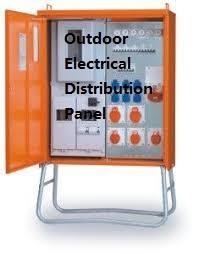Outdoor Electrical Distribution Panel Selection Guide by Nante for Technicians

When project teams plan exterior power systems, the specification of an Outdoor Electrical Distribution Panel often determines long-term reliability, and early selection of the Outdoor Electrical Distribution Panel helps align protection, ingress rating, and service access with real site conditions. Good early choices reduce retrofit work, improve uptime, and make maintenance predictable for operations teams that must manage weather, vandalism, and seasonal stresses.
Assessing site challenges and exposure
Every outdoor installation has unique stresses. Note proximity to salt air, industrial emissions, washdown procedures, and direct sunlight. Also consider mechanical risks — impact from equipment, vehicles, or vandalism — and whether the panel will be exposed to repeated thermal cycling. A thorough site analysis guides material choice, mounting strategy, and sealing approaches that keep internal components dry and safe.
Material choices and corrosion mitigation
Materials determine how long an exterior distribution assembly will last. Stainless steel gives excellent corrosion resistance in coastal settings; powder-coated aluminum balances durability with lighter weight; engineered composites offer nonconductivity and UV stability. Pay attention to fastener metallurgy and terminal platings to avoid galvanic corrosion. Where needed, specify sacrificial coatings or additional sealant strategies for highly aggressive chemical environments.
Thermal performance and internal layout
Heat buildup shortens component life and increases failure risk. Design internal layouts that allow for heat dissipation: dedicated compartments for high-loss devices, thermal paths to chassis, and spacing that prevents crowded terminations. Where ventilation is possible, use filtered vents that preserve ingress protection. For high-power applications, consider heat-sinking rails or remote mounting of transformers and converters to reduce panel temperature.
Nante modularity and serviceability
Nante offers modular panel families that simplify installation and servicing. Removable gland plates, preconfigured mounting rails, and configurable cutouts let installers adapt layouts without cutting new holes on site. Factory-applied seals and bench testing reduce commissioning time and field troubleshooting. Modular inserts for surge protection, metering, and communications ensure a single enclosure can support mixed power and signaling needs now and into the future.
Installation best practices that preserve ratings
Even the best enclosure will fail if mounted or wired incorrectly. Use appropriate anchors for the substrate, avoid over-compressing gaskets with uneven flange torque, and select correctly sized glands with proper strain relief. Verify terminal torque values and route high-current conductors away from signal wiring. After installation, perform a practical water spray test or visual inspection to confirm seals before handing over to operations.
Monitoring, smart protection, and lifecycle planning
Modern outdoor distribution solutions increasingly integrate sensors for humidity, temperature, and door status. Embedding condition monitoring enables predictive maintenance and early fault detection. Pair panels with remote trip capabilities, metering, and energy telemetry to optimize loads and spot trends before they cause outages. Plan a spares strategy — gaskets, common inserts, and terminal blocks — to minimize downtime when replacements are required.
Maintenance schedules and documentation
Regular inspections preserve protection ratings and prevent surprises. Check gasket condition, fastener tightness, and signs of terminal discoloration that indicate overheating. Maintain installation records — gland sizes, torque values, and wiring diagrams — so future technicians can reproduce original performance. Keeping a small inventory of replacement seals and common components significantly reduces mean time to repair.
Choosing the right family for long-term value
Balance upfront cost against lifecycle risk. Overspecified products add unnecessary expense; underspecified units raise failure probability. Favor systems with replaceable seals, modular inserts, documented factory testing, and accessible terminal areas. Early collaboration among designers, installers, and the enclosure supplier yields panels that meet real needs and simplify long-term upkeep.For product families, factory test reports, and configurable solutions tailored to harsh outdoor environments, see https://www.nante.com/news/industry-news/outdoor-electrical-distribution-panel-nante.html
- Sports
- Art
- Causes
- Crafts
- Dance
- Drinks
- Film
- Fitness
- Food
- Spiele
- Gardening
- Health
- Startseite
- Literature
- Music
- Networking
- Andere
- Party
- Shopping
- Theater
- Wellness


